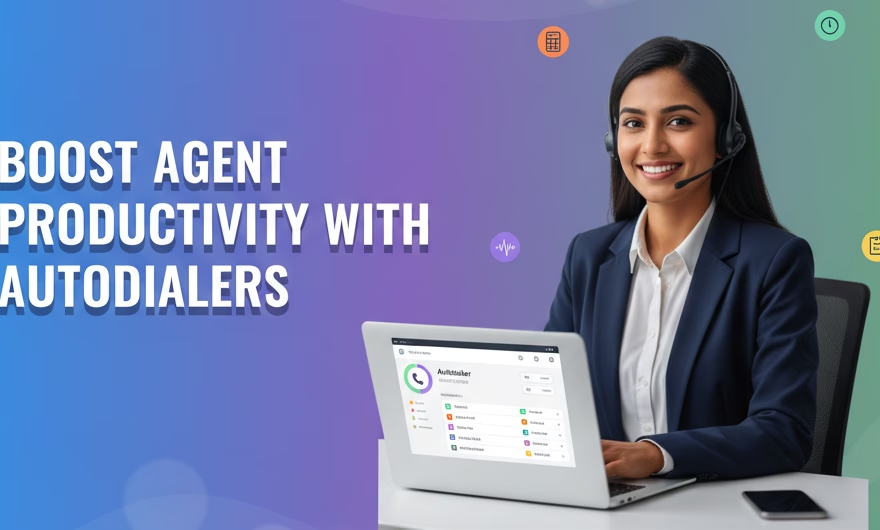An auto dialer adds efficiency by allowing agents to work on other aspects of the call while it dials phone numbers and screens out voicemails. By automating repeatable steps like dialing, detecting busy tones, and skipping unreachable contacts, an autodialer frees up agents to focus on conversations that matter. This software helps agents get time and information to prepare, enabling them to offer personalized experiences and enhance success rates.
Modern autodialers integrate with your CRM to present screen-pops with customer context, automatically log outcomes, and schedule follow-ups. They can also enforce calling rules, such as honoring do-not-call preferences and limiting contact attempts, so agents don’t have to think about compliance while they work. The result is higher connect rates, more productive talk time, and lower fatigue from manual tasks like punching in numbers or leaving the same voicemail repeatedly.
The result is higher connect rates, more productive talk time, and lower fatigue from manual tasks like punching in numbers or leaving the same voicemail repeatedly.
At a high level, autodialers improve agent productivity through the following:
- Reduced idle time: The system handles ringing, call retries, and skipping invalid numbers, so agents are rarely waiting for the next conversation.
- Higher connect density: Smart detection filters out voicemails and unanswered calls to route only live connections to agents.
- Better preparation: With CRM data on screen, agents personalize greetings, verify details faster, and drive more effective outcomes.
- Automatic record-keeping: Dispositions, notes, and callbacks are captured consistently, improving follow-through without adding admin burden.
- Consistent pacing: The dialer manages the rhythm of outreach, helping teams maintain momentum across large lists without over or under-dialing.
Two dialer modes commonly used to lift agent productivity are power dialers and predictive dialers. Each serves a specific operational need and can be tuned to balance customer experience, compliance, and efficiency.
» Power Dialer
Power dialer sequentially dial the next number once the agent finishes the current call. The agent indicates their availability, and the dialer automatically dials the next call. If a number is unattended, busy, or disconnected, power dialers automatically move to the next number. This saves agents a lot of time by reducing manual tasks and proportionally increasing productivity.
Because power dialers maintain a one-to-one connection between an agent and a call attempt, they’re ideal when conversations require preparation or when there are stricter compliance needs. Agents can review a record quickly before each dial, greet the customer by name, and tailor the talk track to the context shown on their screen. This blend of automation and control increases confidence and typically leads to better first-call outcomes.
Common scenarios where power dialers excel include:
- High-value sales and B2B outreach: Agents benefit from a short preview to personalize the opening and confirm eligibility before dialing.
- Customer success and renewals: Calls often require account context and a consultative tone, making one-to-one pacing ideal.
- Collections with right-party focus: When right-party contact is critical, controlled pacing with quick retries can lift connect quality.
- Service callbacks and appointment confirmations: Agents can review case details and notes before engaging.
To maximize agent productivity with a power dialer, consider these practices:
- Segment lists and set call windows: Group by time zone, priority, and previous outcomes to boost reachability and reduce wasted dials.
- Use voicemail drop where allowed: If regulation in your region permits, let agents drop a pre-recorded message and immediately move on to the next call.
- Automate dispositions and callbacks: Offer one-click outcomes that schedule follow-ups and update the CRM without manual typing.
- Tune after-call work (ACW): Give agents enough time to summarize the call but avoid overly long ACW that slows throughput.
- Keep data quality high: Validate numbers, remove duplicates, and respect do-not-call lists to avoid wasted attempts and compliance risk.
When set correctly, a power dialer keeps agents steadily engaged, reduces cognitive switching, and creates a reliable rhythm that lifts conversations per hour without sacrificing quality.
» Predictive Dialer
The predictive dialer simultaneously makes multiple outbound calls and connects a customer answering the call to the next available agent. It differs in that it uses several variables to predict agent availability, such as how long an agent takes for a call and the likelihood of a customer answering. For example, if an agent typically takes 3 minutes per call, the dialer will initiate a new call every 4 minutes for that agent to optimize call flow and preparation time.
Predictive dialers are designed for scale. By analyzing agent occupancy, average handle time, answer rates, and recent connect trends, they “pace” how many numbers to dial ahead of agent availability. When calibrated well, predictive dialing reduces idle time dramatically and increases the number of live conversations per hour. The trade-off is that the system takes more control over call flow, so configuration and monitoring are essential to protect customer experience.
Key capabilities that drive agent productivity with predictive dialing include:
- Adaptive pacing: The system adjusts dial-ahead ratios in real time to maintain high occupancy without overwhelming agents.
- Answering machine detection (AMD): Accurately identifying voicemail helps route only live answers to agents and discard non-productive calls.
- Abandonment safeguards: Controls such as maximum abandonment thresholds and quick drop handling reduce silent or short calls for customers.
- Load balancing: Calls are distributed to the best-suited available agent pool, evening out workload and improving consistency.
- List penetration management: The dialer can cycle through lists intelligently, applying retry rules based on previous outcomes and time of day.
To get the most out of predictive dialing while maintaining quality and compliance, teams should:
- Calibrate pacing to your operation: Start conservatively, evaluate occupancy and abandonment, then gradually increase aggressiveness until you find the sweet spot.
- Monitor abandonment and callback logic: Ensure customers who couldn’t be connected promptly are queued for fast agent callbacks when appropriate.
- Tune AMD settings: Optimize sensitivity to minimize false positives that drop live answers or pass machines to agents.
- Set clear attempt limits: Cap retries per contact and space them to avoid customer fatigue and maintain list health.
- Invest in agent readiness: Provide concise screen-pops and talk tracks so agents can handle fast-arriving connects with confidence.
When executed with care, predictive dialing can multiply productive talk time across large teams, helping leaders hit ambitious outreach goals while keeping agent effort focused on conversations—not on dialing.
These autodialer features work together to boost agent efficiency, reduce idle time, and increase productive talk time, ultimately improving overall call center results and agent productivity. Power dialers give agents control and context for higher-quality conversations, while predictive dialers maximize scale with intelligent pacing. In both modes, the biggest gains come from clean data, thoughtful retry rules, CRM integrations for instant context, and simple workflows for dispositions and callbacks. With these foundations in place, teams can create a steady, sustainable calling rhythm that keeps agents energized, customers better served, and outcomes consistently improving into 2025 and beyond.




